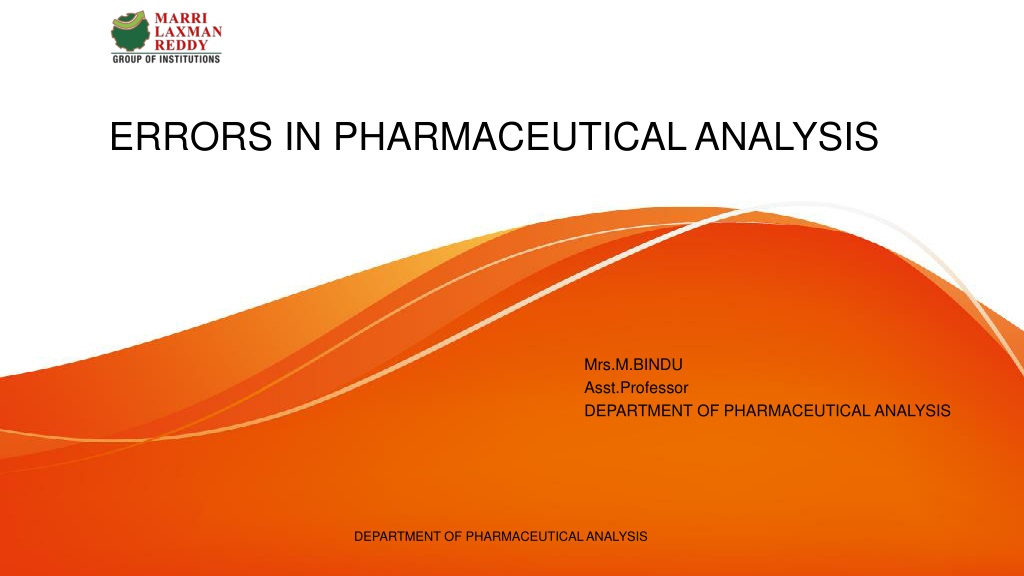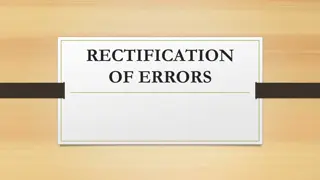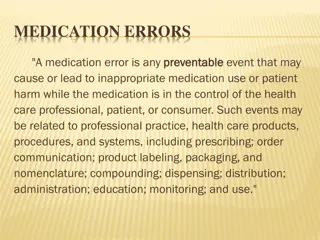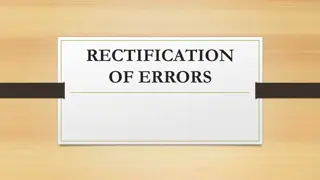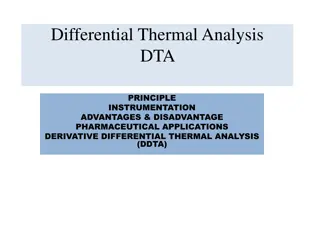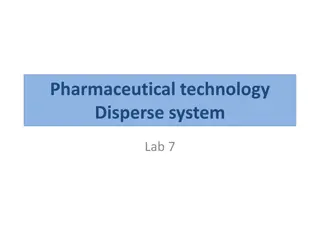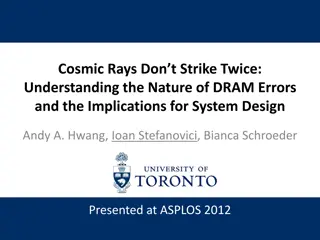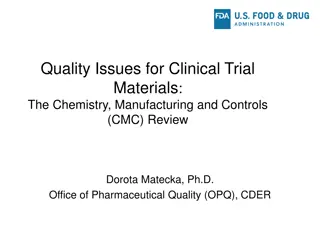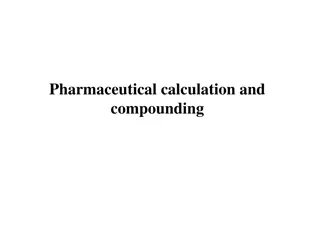Understanding Errors in Pharmaceutical Analysis
This article explores different types of errors in pharmaceutical analysis, such as determinate and indeterminate errors, and discusses their impact on analysis results. It also covers the concepts of accuracy, precision, and minimizing systematic errors in analytical chemistry. The importance of identifying and correcting errors in analysis is crucial to ensuring reliable and accurate results in pharmaceutical testing.
Download Presentation

Please find below an Image/Link to download the presentation.
The content on the website is provided AS IS for your information and personal use only. It may not be sold, licensed, or shared on other websites without obtaining consent from the author. Download presentation by click this link. If you encounter any issues during the download, it is possible that the publisher has removed the file from their server.
E N D
Presentation Transcript
ERRORS IN PHARMACEUTICAL ANALYSIS Mrs.M.BINDU Asst.Professor DEPARTMENT OF PHARMACEUTICAL ANALYSIS DEPARTMENT OF PHARMACEUTICAL ANALYSIS
Introduction Classification of errors a. Determinate Errors b. Indeterminate Errors c. Accuracy d. Precision e. Minimizing Systematic Errors DEPARTMENT OF PHARMACEUTICAL ANALYSIS
ERROR: Error is the difference between the true result (or accepted true result) and the measured result. If the error in an analysis is large, serious consequences may result. As reliability, reproducibility and accuracy are the basis of analytical chemistry. A patient may undergo expensive & even dangerous medical treatment based on an incorrect laboratory result because of an analytical error. DEPARTMENT OF PHARMACEUTICAL ANALYSIS
What is Error? Error= measured mean value true value true value And the difference between the experimental value and true value is termed as absolute error. Absolute error may be negative or positive. DEPARTMENT OF PHARMACEUTICAL ANALYSIS
Types of errors : There are two principle types of error in analysis : Determinate or systematic error Indeterminate or random error They are caused by faults in the analytical procedure or the instruments used in the analysis. DEPARTMENT OF PHARMACEUTICAL ANALYSIS
Determinate errors are systemic errors i.e. they are not random. As the name indicates that the cause of this type of error may be found out & then either avoided or corrected. A particular determinate error may cause the analytical results produced by the method to be always too high. Another determinate error may render all results too low. Sometimes the error remains constant; All results are too high or too low by the same amount. DEPARTMENT OF PHARMACEUTICAL ANALYSIS
Determinate error can be additive or they can be multiplicative . It depends on the error & how it enters into the calculation of the final result. This determinate error could be the result of an incorrectly calibrated balance. If the balance is set so that the zero point is actually 0.5 mg too high, all masses determined with this balance will be 0.5mg too high. If this balance was used to weigh any std. sol. Used in the laboratory, the std. concentration will be erroneously high,and all of the results obtained using this std. will be erroneously high. DEPARTMENT OF PHARMACEUTICAL ANALYSIS
The error is reported as the absolute error, the absolute value is the difference between the true and measured value. Measured mean value True value = Absolute error Determinate errors may arise from some faulty step in the analytical process. The faulty step is repeated every time the determination is performed. Whether a sample is analyzed 5 times or 50 times, the results may agree with each other but differ widely from the true answer. Systemic error is under the control of the analyst. DEPARTMENT OF PHARMACEUTICAL ANALYSIS
How are determinate errors identified and corrected...? One is to analyze the sample by a completely different analytical procedure that is known to involve no systematic errors. Such methods are often called standard methods ; they have been evaluated extensively by many laboratories & shown to be precise and accurate. If the results from two analytical methods agree, it is reasonable to assume that both analytical procedures are free of determinate errors. DEPARTMENT OF PHARMACEUTICAL ANALYSIS
The 2nd method is to run several analyses of a reference material of known, accepted concentration of analyte. The difference between the known concentration and that measured by analysis should reveal the error. If the results of analysis of a known reference std. are consistently high or low, then a determinate error is involved in the method. DEPARTMENT OF PHARMACEUTICAL ANALYSIS
Determinate error can arise from : uncalibrated balances, improperly calibrated volumetric flasks or pipettes, malfunctioning instruments, impure chemicals, incorrect analytical procedures or techniques and analyst error. DEPARTMENT OF PHARMACEUTICAL ANALYSIS
Analyst error : They may be the result of inexperience, insufficient training. An analyst may use the instrument incorrectly, Perhaps by placing the sample in the instrument incorrectly each time. Setting the instrument to the wrong conditions for analysis. Misreading a meniscus in a volumetric flask as high( or low) DEPARTMENT OF PHARMACEUTICAL ANALYSIS
Operational and Personal errors : These are due to factors for which the individual analyst is responsible and are not connected with the method or procedure they form part of the personal equation of an observer. Examples are: Mechanical loss of materials in various steps of analysis. Underwashing or over washing of precipitates. Ignition of ppts at incorrect temperatures. DEPARTMENT OF PHARMACEUTICAL ANALYSIS
Some analyst are unable to judge color changes sharply in visual titrations, which may result in slight overstepping of the end point. Some other analyst related errors are : Carelessness Transcription errors, i.e. copying the wrong information into a lab notebook or onto a label. Proper training, experience, and attention to detail on the part of the analyst can correct these types of errors. Reagents and instrumentation : Contaminated or decomposed reagents can cause determinate errors. Prepared reagents may also be improperly labeled. DEPARTMENT OF PHARMACEUTICAL ANALYSIS
Impurities in the reagents may interfere with the determination of the analyte, especially at the ppm level or below. Numerous errors involving instrumentation are possible, including Faulty construction of balances, Incorrect instrument alignment, Incorrect wavelength settings, Use of uncalibrated or improperly calibrated weights. DEPARTMENT OF PHARMACEUTICAL ANALYSIS
These problems can be eliminated by a systematic procedure to check the instrument settings and operation before use. Such procedures are called std. operating (SOPs) in the many labs. There should be a written SOP for each instrument and each analytical method used in the laboratory. DEPARTMENT OF PHARMACEUTICAL ANALYSIS
In Instrumental analysis, electrical line voltage fluctuations are a particular problem. This is especially true for automated instruments running unattended overnight. Instruments are often calibrated during the day, when electrical power is in high demand. At night , when power demand is lower, completely changing the relationship between conc. Of analyte and measured signal. DEPARTMENT OF PHARMACEUTICAL ANALYSIS
Analytical Method : The most serious errors are those in the method itself. Examples of method include Incorrect sampling Incomplete reaction for chemical methods, Unexpected interferences from the sample itself or reagents used. Loss of analyte during sample preparation by volatilization or precipitation. DEPARTMENT OF PHARMACEUTICAL ANALYSIS
In titrimetric analysis errors may occur : Failure of reactions to proceed to completion. Occurrence of induced and side reactions. In gravimetric analysis: Decomposition co- precipitation and post precipitation. Precipitation of constituents other than the desired ones DEPARTMENT OF PHARMACEUTICAL ANALYSIS
Contamination: Contamination of sample by external sources can be a serious source of error and may be extremely variable. Aluminum levels in the dust in the normal laboratory are so high that dust prohibits the determination of low ppb levels of aluminum in samples. DEPARTMENT OF PHARMACEUTICAL ANALYSIS
Indeterminate errors : Indeterminate errors can not be pin- pointed to any specific well defined reasons. They are random in nature & take place in several successive measurements performed by the same analyst under the same conditions and identical experimental parameters. DEPARTMENT OF PHARMACEUTICAL ANALYSIS
Sources of random error : Include the limitations of reading balances, electrical noise in instruments and vibrations caused to the building by heavy vehicular- trafficking , which are beyond anyone's control. For eg. A balance that is capable of measuring only to 0.001 g can not distinguish between two samples with masses of 1.0151 & 1.0149 g. In one case the measured mass is low, in the other case it is high DEPARTMENT OF PHARMACEUTICAL ANALYSIS
ACCURACY : An accurate result is the one which matches very nearly with true value of a measured amount. Accuracy is inversely proportional to the error i.e. the greater the accuracy, smaller is the error. DEPARTMENT OF PHARMACEUTICAL ANALYSIS
PRECISION: Agreement among a cluster of experimental results however it does not imply anything with respect to their relation to the true value. Precision designates reproducibility of a measurement, whereas accuracy the correctness of a measurement. DEPARTMENT OF PHARMACEUTICAL ANALYSIS
Minimizing systematic errors: Calibration of instruments, apparatus and applying necessary corrections: Instruments commonly used in lab, such as spectrophotometer, electrical balance etc must be calibrated before use. Pipettes, burettes, volumetric flasks, thermometers must be calibrated. DEPARTMENT OF PHARMACEUTICAL ANALYSIS
The response of most of the instruments changes with time because of wear corrosion or mishandling, etc. The determinate personal errors may be eliminated by care, practice and self discipline DEPARTMENT OF PHARMACEUTICAL ANALYSIS
Analysis of standard samples: The errors of method can be checked by carrying out the analysis of standard sample prepared in such a way that its composition is exactly the same as that of material to be analyzed. For this purpose, standard materials containing carefully analyzed constituents are available from National Bureau of Standards. DEPARTMENT OF PHARMACEUTICAL ANALYSIS
BLANK DETERMINATION: To determine the effect of impurities present in the reagents & vessels used and where it is necessary to locate the exact end point. It may be accomplished by performing a separate parallel estimation, without using the sample. DEPARTMENT OF PHARMACEUTICAL ANALYSIS
Cross checking results by different methods of analysis: In certain specific cases the accuracy of a result may be cross linked by performing another analysis of the same substance by another method. Eg. HCl Solution : It may be assayed either by titration with a std. sol. Of NaOH, or by precipitation and weighing as AgCl. DEPARTMENT OF PHARMACEUTICAL ANALYSIS
Significant Figures: A figure of digit denotes any one of the ten numerals (0,1,2,3,4,5,6,7,8,9). A digit alone or in combination serves to express a number. A significant figure is a digit having some practical meaning, i.e. it is a digit, which denotes the amount of the quantity in the place in which it stands. For example in 0.456, 4.56 and 456 there are three significant figures in each number. Zero may or may not be a significant figure. DEPARTMENT OF PHARMACEUTICAL ANALYSIS
A zero is a significant figure except when it serves to locate the decimal point, while it is a significant figure when it indicates that the quantity in place in which i.e. in 1.3680 and 1.0082, zero is significant but in 0.0035, zeros are not the significant figures as they serve only to locate the decimal point. Thus, first two numbers contain five but the third one contains two significant figures. DEPARTMENT OF PHARMACEUTICAL ANALYSIS
Computation Rules: Rule 1 In expressing an experimental measurement, never retain more than one doubtful digit. Eliminate all the digits that are not significant. Rule 2 Retain as many significant figures in a result or in any data as will give only one uncertain figure. e.g. a volume between 30.5 ml and 30.7 ml should be written as 30.6 ml. and not as 30.60 as it would be between 30.59 and 30.61. Rule 3 Two rules are given for rejecting superfluous digits. DEPARTMENT OF PHARMACEUTICAL ANALYSIS
1. When the last digit dropped is greater than 5, the last digit retained is increased by one. e.g. in rejecting the last digit in 8.947, the new value will be 8.95 as 7 is greater than 5. But when 4.863 is rounded up to two digits, it gives 4.9 as the first digit discarded is 6 which is greater than 5. This is known as rounding up. 2. If the first digit discarded is less than 5, leave the last digit unchanged. It is known as rounding down. e.g. when the number 5.64987 is rounded to two digits, we get 5.6 as the first digit, discarded is 4, which is less than 5. DEPARTMENT OF PHARMACEUTICAL ANALYSIS
Rounding never changes the power of 10. Thus, it is better to express numbers in exponential notation before rounding. e.g. in rounding 57832 to four figures, result 5.783 X 104 Rule 4 In addition or subtraction, there should be in each number only as many significant figures as there are in the least accurately known number. e.g. sum of three values 35.6, 0.162 and 71.41 should be reported only to the first decimal place as the value 35.6 is known only to the first decimal place. Thus, the answer 107.172 is rounded to 107.2. DEPARTMENT OF PHARMACEUTICAL ANALYSIS
Rule 5 In multiplication or division, retain in each factor one more significant figure than is contained in the factor having the largest uncertainty. The percentage precision of a product or quotient cannot be greater than the percentage precision of the least precise factor entering into the calculation. e.g. the product of the three figures 0.0121, 25.64 and 1.05782 is 0.0121 X 25.6 X 1.06 = 0.328. DEPARTMENT OF PHARMACEUTICAL ANALYSIS
In a product or quotient of experimental numbers, the final result will have only as many significant figures as the factor with smallest number of significant figures. e.g. in the calculation, ,least number of significant figures (3) is in 0.218. Thus, the answer should also be expressed in three significant figures. When a calculation involves both addition or subtraction and multiplication or division, addition is done first so as to determine the number of significant figures in the answer. DEPARTMENT OF PHARMACEUTICAL ANALYSIS
Rule 6 Computation involving a precision not greater than one fourth of 1 % should be made with a 10-inch slide rule. For greater precision, logarithm tables should be used. Slide rule is a good method for checking the calculations made by logarithms. Use of logarithms has been recommended where a large number of multiplications and divisions are to be made. DEPARTMENT OF PHARMACEUTICAL ANALYSIS
